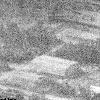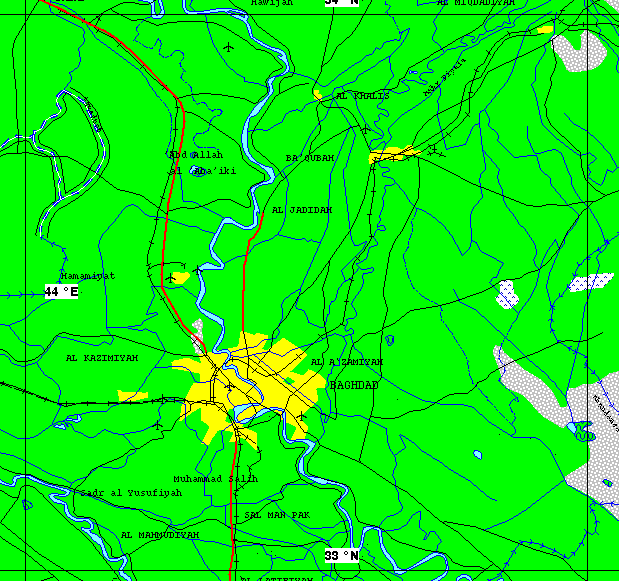





 Tuwaitha Nuclear Research Center, located 18 km SSE of Baghdad, was the main site for Iraqi nuclear program. Tuwaitha is the location of the Osiraq reactor bombed by Israel in 1981. The Al Asil General Establishment at Al Tuweitha was the headquarters of the Iraqi Nuclear Commission. Activities included several research reactors, plutonium separation and waste processing, uranium metallurgy, neutron initiator development and work on number of methods of uranium enrichment. The Pure Lead Project at Al Tuweitha was engaged in the development of shielding for the nuclear weapons program.
Tuwaitha Nuclear Research Center, located 18 km SSE of Baghdad, was the main site for Iraqi nuclear program. Tuwaitha is the location of the Osiraq reactor bombed by Israel in 1981. The Al Asil General Establishment at Al Tuweitha was the headquarters of the Iraqi Nuclear Commission. Activities included several research reactors, plutonium separation and waste processing, uranium metallurgy, neutron initiator development and work on number of methods of uranium enrichment. The Pure Lead Project at Al Tuweitha was engaged in the development of shielding for the nuclear weapons program.
At a location immediately outside Tuwaitha parts for the enrichment program were reportedly stored. Also outside Tuwaitha is a facility where magnetic coils and insulators were manufactured. Neither of these facilities were bombed during the Gulf War. Facility 416, the storage and warehouse area at Tuwaitha, was not at all damaged during the Gulf War. Facility 405 at Tuwaitha, operated by the Iraqi Atomic Energy Commission (IAEC) and the basis for the 411 Program ( the al-Tarmiya enrichment facility), was probably totally destroyed. [GulfLINK]
Experiments on enrichment were conducted in the Laboratory Workshop Building (LWB). Operations in this building focused on the enrichment of uranium work included experiments with centrifuge, electromagnetic separator, and laser separation experiments. Also in this building was a group working on chemical processes using acetone. The "hot laboratories" were located in the lama building. [GulfLINK]All nuclear fuel at this site was removed under IAEA monitoring. Equipment directly tied to the nuclear weapons program was destroyed in place.
In April 1991, Iraq’s inventory of safeguarded highly enriched uranium included 35.58 kilograms of U235 which had been irradiated but could not be readily used in weapons production since the fissile material would have been difficult to extract quickly from the irradiated fuel. This material was held at two storage locations: a fuel pond, which contained the reactor core and fuel storage racks; and an emergency storage where fueld from the Tammuz-2 reactor core and associated pond had been transferred during the Gulf War. This emergency storage, designated "location B", consisted of pits in a farmland area a few miles from the Al Tuwaitha Nuclear Center. [IAEA April 1992 ]During the Gulf War the allied forces bombing of Iraqi facilities inflicted a maximum of 20 percent damage on the Iraqi nuclear weapons development program. Most of the damage occurred in two facilities--the headquarters (HQ) of the Iraqi nuclear weapons program, called the Tuwaitha or al-Diyalla facility, located on the southeastern edge of Baghdad, and the al-Safaa uranium enrichment factory located north of Baghdad. Allied forces bombing inflicted a great amount of damage on Tuwaitha; however, most of the facilities destroyed belonged to the Iraqi Nuclear Power Commission or were administrative facilities. The reactor building and a small test reactor, which remained from the time that Osirak was built both were destroyed. One production unit was damaged. This unit processed spent nuclear fuel and contained two hot cells for this purpose. Bombing of this unit caused some nuclear contamination. Because of the contamination, Tuwaitha was closed for two days after the bombing. The nuclear reactor building was damaged. The reactor inside the building was shut down before the gulf war. [GulfLINK]
The Al Tuwaitha nuclear center was extensively equipped with "hot cells" for dealing with radioactive material, although many were severely damaged during bombing. However, concern remained about possible reconstruction and future use of the undamaged cells. Therefore, during the seventh inspection, these cells were rendered harmless by cutting off the manipulator arms and control wires. Associated glove boxes were rendered useless by pouring cement into them. As a long-term measure, epoxy resin was used along with cement to render harmless the mixers-settlers. The seventh and eighth IAEA inspections revealed special equipment essential to the nuclear weaponization programme for warhead development and assembly as distinct from nuclear material production. Two special video cameras ("streak cameras") were removed from Iraq and other equipment was sealed pending decisions on removal, destruction or monitoring. [IAEA April 1992 ]

